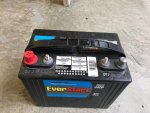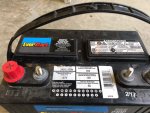It's tough to get that many years out of a battery here with the summer heat we have. The best I've ever done was six years out of an Optima Red Top (AGM).To add to the point, I've been noticing many (OEM) batteries which are maintenance free have a welded plastic cap on the vents. Kind of a pain to remove and involves significant prying. Other maintenance free batteries hide the caps under the sticker which is alot easier to access.
I seem to be getting ~10 years from my OE batteries and that's with no maintenance and no checks other than following general best practices (eg. never discharging them) so I wonder if it's even necessary to go above and beyond with these.
You are using an out of date browser. It may not display this or other websites correctly.
You should upgrade or use an alternative browser.
You should upgrade or use an alternative browser.
Filling batteries
- Thread starter Donald
- Start date
Just pulled the battery out of the boat for the winter. You can clearly see the two rectangular caps you pop up with screwdriver. I fill until the reflection turns upside down. ( just to the bottom of the of the tube). The tube has a slot to allow outgassing. So far it has survived four summers of 80-90 degree weather. I have never been stranded by it. If there is some advantage to leaving the level lower, I have never noticed it. Still load tests fine.




- Joined
- Sep 25, 2020
- Messages
- 186
Worked in coal for several years in an all electric mine. For our weekly battery scoop maintenance we always ensured that each of the 120v batteries 64 cells had water atleast covering the plates
Donald
Thread starter
Just pulled the battery out of the boat for the winter. You can clearly see the two rectangular caps you pop up with screwdriver. I fill until the reflection turns upside down. ( just to the bottom of the of the tube). The tube has a slot to allow outgassing. So far it has survived four summers of 80-90 degree weather. I have never been stranded by it. If there is some advantage to leaving the level lower, I have never noticed it. Still load tests fine.
View attachment 31275View attachment 31276
The sulfuric acid wicks up so just below what you do is best. But I have done what you do for many years.
Hopefully you put it on a float charger for the winter.
Nope. No float charger for me. Two charge touch ups during the winter and good to go. To each his own. Also, even with the fluid level at the tube, during a hot summer it drops below, anyway, so it ends up like your method.
Actually, here is a good way of taking some of the opinions and putting it together. I like to touch the bottom of the tube. That way I have the maximum amount of water and very low risk of letting it go below the plates. Here is the description:

Donald
Thread starter
Actually, here is a good way of taking some of the opinions and putting it together. I like to touch the bottom of the tube. That way I have the maximum amount of water and very low risk of letting it go below the plates. Here is the description:
View attachment 31368
And just to state the obvious, wear safety glasses while filling.
I am sure they existed when I was a kid but I have never seen non maintenance free automotive batteries since I started driving in the mid 90s or ever added water to one. We always get 10 years out of a battery.
Donald
Thread starter
I am sure they existed when I was a kid but I have never seen non maintenance free automotive batteries since I started driving in the mid 90s or ever added water to one. We always get 10 years out of a battery.
The maintenance free batteries came about as the battery companies developed better lead alloys for the plates.
Having sophisticated voltage regulators helped also.
I remember my Dad doing something with the voltage regulator for the generator in his car. Before alternators. It might not have been a voltage regulator, but some kind of control box for the the charging rate of the generator. He would bend a spring or something. Probably late 1950s. I was a wee kid.
Last edited:
The batteries I have used for years that had removable caps had a well above the plates with two slots. When the proper level was reached the arrangement turned to a eye shape. Some of the Die Hard batteries used to have a a clear plastic tube that darkened when the electrolyte was at the proper level.
Haven't seen an eye in an aftermarket battery before. I remember those in older batteries in a GM car. There might have been one in a Japanese battery.The batteries I have used for years that had removable caps had a well above the plates with two slots. When the proper level was reached the arrangement turned to a eye shape. Some of the Die Hard batteries used to have a a clear plastic tube that darkened when the electrolyte was at the proper level.
I've dealt with Japanese OEM batteries from Yuasa, Panasonic, or whatever Subaru used in my WRX. Don't remember the company for the Subaru, but it wasn't a well known company like Yuasa or Panasonic. A lot of Japanese OEM parts comes from smaller suppliers.
All of these had removable caps - either the ones with a screw slot or with knobs. The top was always black and the case was always a semi-translucent white. If level, I could clearly see where the electrolyte level was - at least with a flashlight. There was a minimum line and a maximum line. I can't really find anything of a car battery, but here's one designed for a motorcycle that has caps and electrolyte level lines. Not sure what's up with the wide range in acceptable electrolyte level.

Similar threads
- Replies
- 12
- Views
- 650
- Replies
- 81
- Views
- 10K
